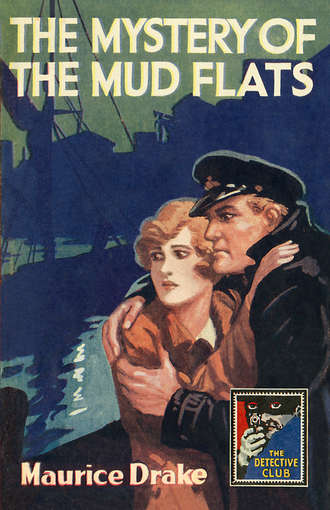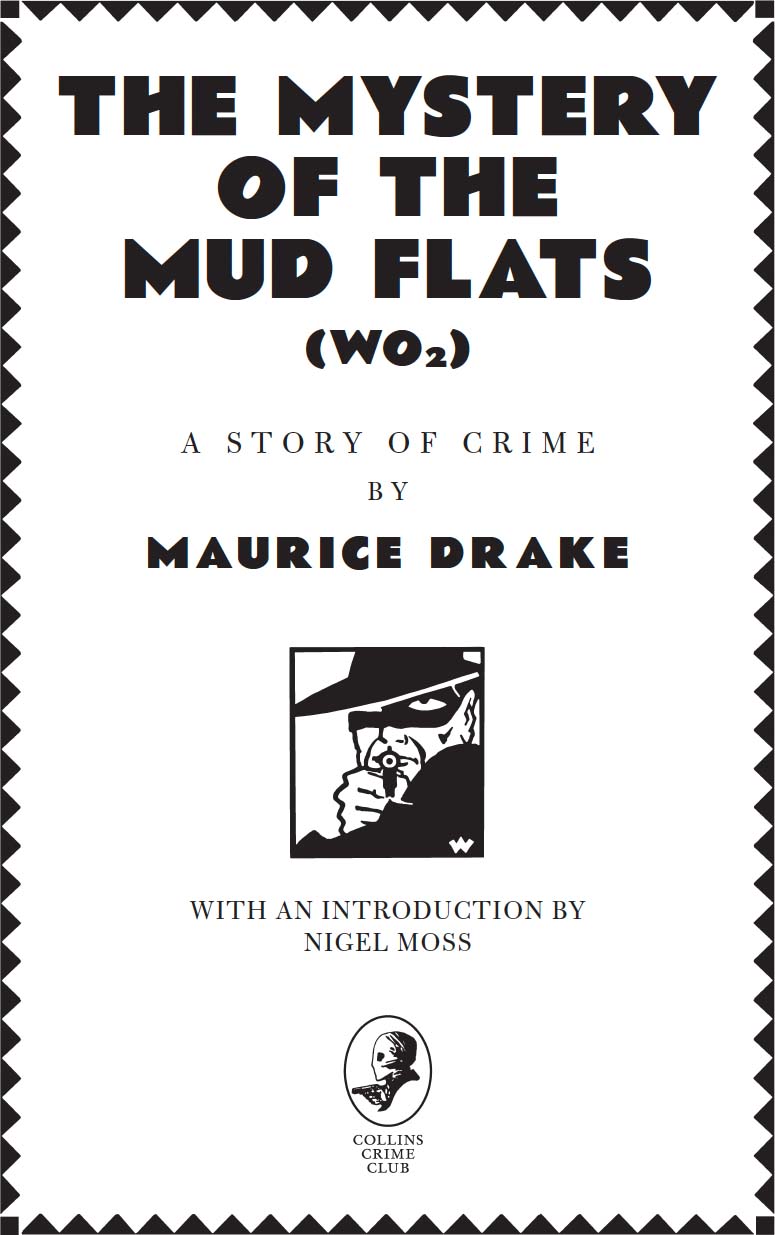
Полная версия
The Mystery of the Mud Flats

‘THE DETECTIVE STORY CLUB is a clearing house for the best detective and mystery stories chosen for you by a select committee of experts. Only the most ingenious crime stories will be published under the THE DETECTIVE STORY CLUB imprint. A special distinguishing stamp appears on the wrapper and title page of every THE DETECTIVE STORY CLUB book—the Man with the Gun. Always look for the Man with the Gun when buying a Crime book.’
Wm. Collins Sons & Co. Ltd., 1929
Now the Man with the Gun is back in this series of COLLINS CRIME CLUB reprints, and with him the chance to experience the classic books that influenced the Golden Age of crime fiction.

Copyright
COLLINS CRIME CLUB
an imprint of HarperCollinsPublishers Ltd
1 London Bridge Street
London SE1 9GF
www.harpercollins.co.uk
First published in Great Britain as WO2 by Methuen & Co. 1913
Published as The Mystery of the Mud Flats by The Detective Story Club Ltd for W. Collins Sons & Co. Ltd 1930
Introduction © Nigel Moss 2018
Cover design © HarperCollinsPublishers Ltd 1929, 2018
A catalogue copy of this book is available from the British Library.
This novel is entirely a work of fiction. The names, characters and incidents portrayed in it are the work of the author’s imagination. Any resemblance to actual persons, living or dead, events or localities is entirely coincidental.
All rights reserved under International and Pan-American Copyright Conventions. By payment of the required fees, you have been granted the non-exclusive, non-transferable right to access and read the text of this e-book on screen. No part of this text may be reproduced, transmitted, down-loaded, decompiled, reverse engineered, or stored in or introduced into any information storage and retrieval system, in any form or by any means, whether electronic or mechanical, now known or hereinafter invented, without the express written permission of HarperCollins.
Source ISBN: 9780008168926
Ebook Edition © January 2018 ISBN: 9780008137311
Version: 2017-11-17
Contents
Cover
Title Page
Copyright
Introduction
I. CONCERNING A FOOL AND HIS MONEY
II. CONCERNING A STROKE OF GOOD LUCK AND AN ACT OF CHARITY
III. CONCERNING A COMPANY OF MERCHANT ADVENTURERS
IV. CONCERNING A CARGO OF POTATOES
V. IN THE MATTER OF A DESERTING SEAMAN
VI. OF A PRODIGAL’S RETURN
VII. CONCERNING A PENALTY FOR CURIOSITY
VIII. FURTHER RESULTS OF CURIOSITY
IX. OF CURIOSITY REWARDED
X. OF A PARTNERSHIP IN CRIME
XI. OF A LADYLIKE YOUNG PERSON
XII. CONCERNING THE ETHICS OF PARTNERSHIP
XIII. SHOWING A FOWLER IN HIS SNARE
XIV. OF A DIRECTORS’ MEETING
XV. CONCERNING MODERN MAIDENHOOD
XVI. OF A CONVIVIAL GATHERING
XVII. VOOGDT DESERTS AGAIN
XVIII. OF A NONDESCRIPT CREW
XIX. WHICH TELLS OF A WILD-GOOSE CHASE
XX. OF A DISSOLUTION OF PARTNERSHIP
XXI. OF COLLISIONS AT SEA
The Detective Story Club
About the Publisher
INTRODUCTION
MAURICE DRAKE’s more enduring legacy to date has been as a leading artist in glass painting and eminent authority on medieval stained glass, working in the early twentieth century. By contrast, his fictional writings and reputation as an author of seven popular novels, originally published between 1906 and 1924, have been largely neglected. This new release of the Collins Detective Story Club edition of The Mystery of the Mud Flats (1930), the first in 88 years, provides an opportunity to appraise Drake’s most successful novel, alongside his other works; also, to reflect on his place within the Edwardian high adventure story genre, and to look more broadly at his influence on later authors of nautically themed mystery and espionage thrillers.
Born in 1875 in Newton Abbot, Devon, Frederick Morris Drake—better known by his pseudonym Maurice Drake—was educated at Teignmouth Grammar School. Along with his brother Wilfred, Maurice Drake represented the fourth generation of a famous glass painting family in Exeter, originally established by his great-uncle. He married Alice Wilson in 1897.The family home and glass painting studio were close to Exeter Cathedral, and he was an advisor to the Cathedral authorities on stained glass—a role to which his daughter succeeded him following his death. Maurice’s best known art publications, which have become leading works in their field, are A History of English Glass-painting (1912) and Saints and their Emblems (1916), both co-authored with Wilfred. He was retained by leading museums and became a renowned lecturer and expert advisor on old stained glass, travelling widely in the UK, Continental Europe and USA.
During WW1, Maurice served both with the Infantry and the RAF. In the early 1920s, he resumed his writing career, but in April 1923 died prematurely from pneumonia at the age of 48. It was the same year that saw the publication of his first novel since the Great War.
A popular British circulating magazine of 1913 described Drake as ‘a big, brawny, moustached sunburned man … who looks what he is … an ardent amateur yachtsman. Everything in connection with the sea interests him, and it was this love for salt-water that led him, some seven years ago, to try his hand at a novel about life on the ocean wave.’
In The Mystery of the Mud Flats (also known as WO2), Drake’s fourth novel, the sea and life aboard boats feature constantly. It proved to be his best-selling and best-received novel. Originally published by Methuen in 1913 under the curious title WO2 (the chemical formula of the valuable substance at the heart of the plot), it was also released in the USA and Canada that year under the same title. Acclaim from reviewers and popular commercial success swiftly followed on both sides of the Atlantic; between 1913 and 1930 the book was published in 26 editions world-wide and in three languages. When Collins acquired the publication rights in 1930 for its Detective Story Club imprint, the title was changed to the more accessible (and thrilling) The Mystery of the Mud Flats, and subtitled ‘A Story of Crime’. Interestingly, in 1913, the UK first edition of WO2 was subtitled ‘A Novel’; and the US first edition ‘A Story of Romantic Adventure’. The later change of subtitle in 1930 reflects the rapid growth in popularity of crime stories during the intervening period. By then, the ‘Golden Age’ of mystery fiction was well under way.
Upon the book’s original publication in 1913, the New York Times reflected on the market being flooded with tales of romance, adventure and melodrama, of which few could be classed as literature. While lamenting a lack of authors of the calibre of Dumas, Scott or Stevenson, it was nonetheless sufficiently impressed by WO2 to comment that it represented ‘a rift in the dark outlook for romance in a day of clinical novels and potboilers. The author … is on the right track, and his book is so far above the average hotchpotch of remarkable and incongruous events as to deserve special comment. WO2 is a stirring tale of illicit sea-faring, full of open air thrill … a rattling good yarn, and stands well to the front among books of its kind.’ Scribners magazine applauded the ingenious plot and originality in characterisation. The Nation reviewer concluded: ‘It is not often that detective work, vagabond adventure and love-making are more pleasantly mingled’.
WO2 or The Mystery of the Mud Flats is a model of the Edwardian high adventure story—the tropes of thrills, heroism, mystery and romance are all present in good measure. It blends a mix of themes: a full-blooded, lively paced adventure story with an original and unusual plot and a varied and interesting group of characters; illicit smuggling; gripping and dangerous espionage activity; exciting action at sea, with plenty of sailing detail and sea-faring dialogue; wonderfully descriptive writing, especially of the Dutch Scheldt coastal locations, and evoking life at sea often in bleak conditions; a non-intrusive love interest involving a young woman with thoroughly modern ideas; and, written only a year before WW1, there is a clear foreboding of the growing menace of Germany as a military power. The story is narrated in the first person throughout, and the writing is direct, crisp and terse.
The narrator is James Carthew-West, a fiercely independent, educated young man from an upper middle-class background, whose reading interests include Marcus Aurelius, Balzac and Henry James. He has a consuming passion for the sea, and when we meet him is already an experienced and well-travelled seaman, the owner and skipper of a coasting ketch Luck and Charity, moored in Exmouth harbour. While resourceful and capable, Carthew-West is also prone to periods of idleness and impecuniosity. In the book’s vivid opening passages he is found at a particularly low point: destitute, hung-over, unwashed and unkempt, having slept out on a beach all night—‘I woke on Exmouth beach that early summer morning much as I should think a doomed soul might wake, Resurrection Day’. But Carthew-West’s ill-fortune is about to change for the better. His reverie is rudely disturbed by a young lady, Pamela Brand. A sparky personal chemistry between the two quickly develops. His initial views about Pamela being ‘a sexless little guttersnipe’ and ‘viper tongued’, and her corresponding disgust with his wasted life, gradually give way to a mutual love interest as the story progresses. Pamela is likewise a strongly independent character. She holds a BSc, and is an enthusiastic supporter of the suffragette movement, with forthright views on the role of women in society; very much a modern woman for her time.
Pamela introduces Carthew-West to her business partner, Leonard Ward, formerly an eminent Chemistry professor, now running Axel Trading Company which ships various goods between English ports and the Scheldt delta in the Dutch low countries. Ward is impressed with Luck and Charity as a shallow coasting vessel, ideally suited to navigate the waters of the Scheldt, and he charters the boat, along with Carthew-West and crew, on exceptionally generous financial terms. Axel’s base is in the Scheldt at Terneuzen, located at the entrance to the Ghent ship canal, close to the mouth of the river. Drake’s descriptions of the locale and setting are masterly—vivid and atmospheric, yet pared down and succinct (mud flats have rarely appeared so attractive!)
Prior to embarkation from Exmouth with the first shipment for Terneuzen, Drake introduces another central protagonist, Austin Voogdt. His initial appearance is comedic; one reviewer colourfully described him as resembling a debonair tramp. But this is no ordinary tramp. Of Dutch descent, Voogdt was previously an independent investigative journalist working for London newspapers, who swapped city life for the open road and exercise after being diagnosed with TB. Carthew-West takes to Voogdt, and hires him to work as a crew member on Luck and Charity. Upon reaching Terneuzen, they encounter Axel Trading’s local representative, Willis Cheyne. He is a cousin of Pamela and fellow partner in the business; a secretive young man, with a volatile temper and unpleasant nature, prone to drink and gambling. Unsurprisingly, he later turns out to be dishonest and untrustworthy.
The charter operation runs smoothly and is financially rewarding for Carthew-West. But the trade is not all it seems. The cargoes delivered to Terneuzen are invariably loss-making, and the mud ballast brought back to England is apparently worthless. Yet Voogdt discovers that Ward and his partners have become extremely affluent of late. Increasingly perplexed, and with his investigative traits coming to the fore, Voogdt resolves to uncover the puzzle and find out what is really going on. At the same time, a German company begins setting up operations in Terneuzen, close to Axel Trading. Headed by its manager Van Noppen, its business is conducted secretively; initially thought to be fertiliser, then later explosives. But the Germans too exhibit a keen interest in the mud flats.
Voogdt displays talents and abilities more akin to a secret service agent than a journalist. Why does he initially disguise his true persona from Willis Cheyne and Van Noppen? How does he gain access to firearms at short notice, and what of his relationship with shadowy agents who look to him so admiringly as their leader in action? The allusion to British secret service connections is there, but ultimately Drake opts to keep Voogdt as an investigative journalist, motivated primarily by financial gain, rather than by national interest (although the latter is certainly served).
Stories dominated by sea adventures are at the heart of five out of Drake’s seven novels. His knowledge and experience of sailing gives the books an authenticity which enhances their quality. The first, The Salving of a Derelict (1906), also known by its US title The Coming Back of Lawrence Averil, won a Daily Mail prize of £100 in 1906 for best story by a new writer (out of 600 manuscripts submitted). It sold well both in the UK and USA, and quickly established Drake as a popular adventure novelist. Lawrence Averil is the ‘derelict’ in the story’s title, an Oxford-educated young man from a well-to-do family; inclined to the sea from childhood. He is fond of the essays of Ralph Waldo Emerson, and in particular ‘Heroism’ (apt, given the plot’s development). Following the shock of his father’s suicide after the discovery of financial embezzlement, Averil is offered a lifeline by one of his father’s victims to work on a fishing trawler in the North Sea. Life at sea proves arduous and dangerous, as much from the hostility of other crew members as the bleak hardship of the natural elements. The challenges to Averil’s character are formidable, and he is pushed to the limits. Ultimately, the ‘derelict’ proves himself, encouraged by the daughter of his boss, a modern, self-possessed London newspaper woman. There are clear parallels between the characters and personalities of Lawrence Averil and James Carthew-West (of WO2), as well as their respective female partners. Also, one of Averil’s crew members subsequently appears in WO2, working for Carthew-West on Luck and Charity.
Salvage appears again in Drake’s second sea novel Wrack (1910), but this time in its nautical form. A young naval officer, incapacitated from service early in his career, turns to salvage work at sea. The nature of salvage operations, with its risks and chances, is graphically described. The hero’s efforts prove increasingly successful and highly rewarding; there is also a promising romance interest in the background. However, the story takes an unexpected dark twist following a fateful discovery, and subsequent emotional turmoil and tragedy overtake the previous happiness and good fortune of the protagonist.
In between these two sea adventures, Drake wrote Lethbridge of the Moor (1908). Set in Exmouth and Dartmoor, the story concerns the unfortunate and cruel consequences for the young hero, George Lethbridge, of an unpremeditated act, out of character, which causes injury to a gamekeeper during a foolhardy poaching expedition. Lethbridge is sentenced to five years’ penal servitude. The remainder of the story focuses on the hardship of prison life and the misfortunes he suffers. The sensitive character of Lethbridge is sympathetically drawn. During his incarceration, Lethbridge displays admirable qualities of fortitude and stoicism, and commits acts of selfless virtue towards other inmates. A love interest also develops involving the wife of a fellow prisoner. The novel was praised by reviewers for its good and clear literary style, vivid description of Dartmoor scenery, and restrained yet forceful romance.
The popular success of WO2 in 1913 led Drake to write a sequel. The follow-up novel was The Ocean Sleuth (1915), another sea adventure mystery and featuring the same main protagonists as in WO2. The sleuth is Austin Voogdt, now styled ‘Sherlock of the Sea’. The newly married James Carthew-West and his wife Pamela also appear in the story, but only peripherally. Voogdt, the maritime detective, is the hero of the story. The plot is strong, exciting and fast-paced; but different in many ways from Drake’s previous books. An absconding financier with £80,000 in notes is supposedly drowned at sea, after a foreign liner breaks up on rocks off the Lizard in Cornwall. Subsequently, many of the notes reappear as forgeries. At one point, there is an exchange of batches of real and counterfeit notes aboard a train in the Parsons tunnel at Dawlish. Spurred on by his love interest in a female suspect, Voogdt hunts down the real notes and solves the mystery. Both WO2 and The Ocean Sleuth were sufficiently popular to be serialised in leading British adventure story magazines in their respective years of publication.
After military service in WW1, Drake returned to his writing career in the early 1920s. His penultimate novel The Doom Window (1923) was released in the same year as his death. An interesting and unusual story, concerned with the forgery of old glass specimens. The protagonist is with a firm of glass painters in Shrewsbury, and the plot centres on the famous ‘Doom Window’ of a local church. Like Drake, the hero is an expert in judging and making stained glass, and the book includes plenty of technical detail about its manufacture, as well as the ins and outs of the business. The blurb of the US first edition refers to the story being ‘as colorful as the stained glass around which its plot turns’. The Saturday Review was particularly admiring of the scenes which describe the effect on the hero of his first visit to New York, where he visits as a consulting expert, and how he views all sorts of city life there through eyes fresh from an English cathedral town. We know Drake had himself made such a trip to New York to value a collection of old glass, and he will likely have drawn on his personal experiences when writing these descriptive passages.
Drake’s final novel Galleon Gold (1924) was published posthumously in the year after his death. Fittingly a nautical story, this time set in the Hebridean Islands, it is an exciting and realistic sea adventure of mixed fortunes, complete with discreet romance element. The plot concerns the search for, and tracing of, lost galleons and gold. It particularly brings to mind George Birmingham’s popular novel Spanish Gold (1908), which features treasure hunting off the west coast of Ireland.
While WO2 lies squarely within the Edwardian high adventure tradition, it has a wider literary significance. There are parallels with the classic boating thriller The Riddle of the Sands (1903) by Erskine Childers, regarded as one of the finest early secret service stories of literary distinction (alongside Kim by Rudyard Kipling, published the year before). This well-drawn, exciting story of amateur espionage, involving two contrasting young male protagonists sailing in the Baltic and Frisian Islands who stumble across pre-invasion manoeuvres by the German navy, was prescient in calling attention to Germany as a potential threat to Britain, especially at a time (pre-Entente Cordiale) when France was perceived as the nation’s principal enemy. WO2, with its allusions to Germany’s international subterfuge and developing armaments programme, was published in the year leading up to WW1. It forms part of the small but influential body of fiction dubbed ‘invasion literature’, alongside The Riddle of the Sands and The Invasion of 1910 by William Le Quex, published in 1906. All were stories with a purpose, written from patriotic leanings, and intended to raise public awareness of the threat of war with Germany and call for preparedness. Together, they provide an interesting insight into pre-WW1 British perceptions.
These novels were precursors to the adventure spy fiction of John Buchan’s The Thirty-Nine Steps (1915), Conan Doyle’s His Last Bow (1917) and E. Phillips Oppenheim’s The Great Impersonation (1920)—all involving the rounding-up of German spy gangs at the outbreak of WW1. This influence carried over to WW2. A. G. MacDonell’s The Crew of the Anaconda (1940) is in the same vein; it features the tracking down of German spies by the owner of a motor cruiser and his friends in the early days of WW2. It continues the literary association between small boats and international conspiracy threats, in the tradition of The Riddle of the Sands and WO2. One commentator has described The Crew of the Anaconda as a kind of WW2 equivalent to The Thirty-Nine Steps. Other espionage adventure thrillers with a nautical flavour from that period include Hammond Innes’ Wreckers Must Breathe (1940), featuring the Cornish coastline, disused tin mines and a secret U-boat base; also John Ferguson’s Terror on the Island (1942), which involves abstracting an invention from Germany prior to the outbreak of WW2.
R. Austin Freeman’s The Shadow of the Wolf (1925) is a tale involving the forgery of banknotes and murder on board a yacht off Wolf Rock in Cornwall. There is a significant boating influence in several thrillers by A. E. W. Mason, including The Dean’s Elbow (1930), and The House in Lordship Lane (1946) featuring Inspector Hanaud. Mason was himself a secret agent in WW1, as well as a keen yachtsman. One thinks also of various sea mysteries of the 1930s, including those by Taffrail (Captain Taprell Dorling—‘the Marryat of the modern Navy’) such as Mid-Atlantic (1936), John Remenham’s Sea Gold (1930), John C. Woodiwiss’s Mouseback (1939), Peter Drax’s High Seas Murder (1939) and Ernest McReay’s Murder at Eight Bells (1939). Later, a strong nautical theme can be seen in the novels of Andrew Garve, for example The Megstone Plot (1956) and A Hero for Leanda (1959); Edward Young’s espionage thriller The Fifth Passenger (1963); as well as several boating thrillers by J. R. L. Anderson, including Death in the North Sea (1975) from the series featuring Colonel Peter Blair, and Redundancy Pay (1976), also known as Death in the Channel.
Maurice Drake’s influence can also be seen in some of the sea mysteries of famous Golden Age detection writer Freeman Wills Crofts. The Golden Age commentator Curtis Evans has noted that Crofts was a great admirer of Drake’s sea adventure stories, and interestingly maintains he borrowed the surname of Maxwell Cheyne, the protagonist of Inspector French and the Cheyne Mystery (1926), from Willis Cheyne in WO2. There are similarities too between Joan Merrill, the heroine of Crofts’ story and Pamela Brand in WO2. Both stories feature Dartmouth harbour in their plots. Crofts’ earlier novel The Pit-Prop Syndicate (1922) also displays the influence of The Riddle of the Sands and WO2. It centres on investigations by amateur sleuths into illicit smuggling activities, using boats ferrying pit props which sail from the Bordeaux coast canals across to the Humber Estuary.
Time now to rediscover and enjoy afresh the exciting adventures of sea-farers James Carthew-West and Austin Voogdt, as they tackle the strange mystery of the mud flats at Terneuzen, amid increasing dangers to themselves, and against a backdrop of the looming shadow of international conflict.





